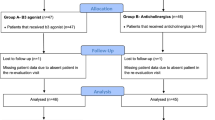Abstract
Urinary disorders are uncommon in the initial phases of multiple sclerosis, but increase in frequency as the disease progresses, with a negative impact on quality of life. The goal of this study was to propose a protocol for the diagnosis and treatment of urinary disorders in multiple sclerosis, based on data from the scientific literature and the experience of Italian clinical centres. In particular, the following clinical aspects were considered: what to do with patients with asymptomatic multiple sclerosis; what to do with symptomatic patients; how and when to perform a second-level diagnostic evaluation; and how to treat urinary disorders. A diagnostic–therapeutic algorithm is proposed, that can be applied in Italian clinical centres.



Similar content being viewed by others
References
De Sèze M, Ruffion A, Denys P et al (2007) The neurogenic bladder in multiple sclerosis: review of the literature and proposal of management guidelines. Mult Scler 13:915–928
Litwiller SE, Frohman EM, Zimmern PE (1999) Multiple sclerosis and the urologist. J Urol 61:743–757
Fowler CJ, Paniker JN, Drake M et al (2009) “A UK consensus on the management of the bladder in multiple sclerosis” J. Neurol Neurosurg Psychiatry 80:470–477
4° Consultazione Internazionale sull’Incontinenza: “Linee Guida sull’incontinenza”—Raccomandazioni ICI 2009—Fondazione Italiana Continenza
Stöhrer M, Blok B, Castro-Diaz D et al (2009) EAU guidelines on neurogenic lower urinary tract dysfunction. Eur Urol 56:81–88
Di Benedetto P, Delneri C, Biasutti E et al (2008) Vesicourethral dysfunction in multiple sclerosis. Initial assessment based on lower urinary tract symptoms and their pathophysiology. Neurol Sci (Suppl 4):S348–S351
Del Popolo G, Panariello G, Del Corso F et al (2008) Diagnosis and therapy for neurogenic bladder dysfunctions in multiple sclerosis patients. Neurol Sci 29(Suppl 4):S352–S355
Motta R, Lopes de Carvalho ML (2008) Management of bladder dysfunction in multiple sclerosis patients: the nurse’s point of view. Neurol Sci 29:S356–S359
Matthews B (1998) Symptoms and signs of multiple sclerosis. In: Compston A et al (eds) McAlpine multiple sclerosis, Churchill Livingstone, London, pp 144–190
Nortvedt MW, Riise T, Frugård J et al (2007) Prevalence of bladder, bowel and sexual problems among multiple sclerosis patients two to five years after diagnosis. Mult Scler 13:106–112
Abrams P, Cardozo L, Fall M et al (2002) The standardisation of terminology of lower urinary tract function: Report from the standardisation sub-committee of International Continence Society. Neurourol Urodyn 21:167–178
Koldewijn EL, Hommes OR, Lemmens WA et al (1995) Relationship between lower urinary tract abnormalities and disease-related parameters in multiple sclerosis. J Urol 154:169–173
Frazer ML, Benson JT, Hashemi CAB et al (2007) Sphincter symptoms as predictors of long-term disability in multiple sclerosis. Arch Neurol 64:1359
Nortvedt MW, Riise T, Myhr KM et al (2001) Reduced quality of life among multiple sclerosis patients with sexual disturbance and bladder dysfunction. Mult Scler 7:231–235
Kirchhof K, Fowler CJ (2000) The value of the Kurtzke Functional Systems Scales in predicting incomplete bladder emptying. Spinal Cord 38:409–413
Bonniaud V, Bryant D, Parratte B, Guyatt G (2008) Development and validation of the short form of a urinary quality of life questionnaire: SF-Qualiveen. J Urol 180:2592–2598
Karsenty G, Denys P, Amarenco G et al (2008) Botulinum toxin A (Botox) intradetrusor injections in adults with neurogenic detrusor overactivity/neurogenic overactive bladder: a systematic literature review. Eur Urol 53:275–287
Kavia RB, De Ridder D, Constantinescu CS (2010) Randomized controlled trial of Sativex to treat detrusor overactivity in multiple sclerosis. Mult Scler 16:1349–1359
Klaskov P et al (1994) BF treatment of bladder dysfunction in MS—a randomized trial. Scan J Urol Nephrol suppl 157:61–65
Vahtera T et al (1997) Pelvic floor rehabilitation is effective in patients with MS. Clin Rehabil 11:211–219
De Ridder D et al (1999) Pelvic Floor rehabilitation in MS. Acta Neurol Belg 99:61–64
Krivoborodov GG et al (2002) Afferent stimulation of tibial nerve in patients with hyperactive bladder. Urology 5:36–39
Amarenco G et al (2003) Urodynamic effect of acute transcutaneous posterior tibial nerve stimulation in overactive bladder. J Urol 169:2210–2215
McClurg D et al (2006) Comparison of pelvic muscle training, electromyography biofeedback, and neuromuscular electrical stimulation for bladder dysfunction in people with MS: a randomized pilot study. Neurourol Urodyn 25:337–348
Kabay SC et al (2008) Acute effect of PTNS on neurogenic detrusor overactivity in patients with MS: urodynamic study. Urology 71:641–645
Lopes ML et al (2010) Effectiveness of rehabilitation on urinary disorders in MS. Neurol Sci 31(Suppl.):454
Author information
Authors and Affiliations
Consortia
Corresponding author
Rights and permissions
About this article
Cite this article
Ghezzi, A., Carone, R., Del Popolo, G. et al. Recommendations for the management of urinary disorders in multiple sclerosis: a consensus of the Italian Multiple Sclerosis Study Group. Neurol Sci 32, 1223–1231 (2011). https://doi.org/10.1007/s10072-011-0794-y
Published:
Issue Date:
DOI: https://doi.org/10.1007/s10072-011-0794-y




